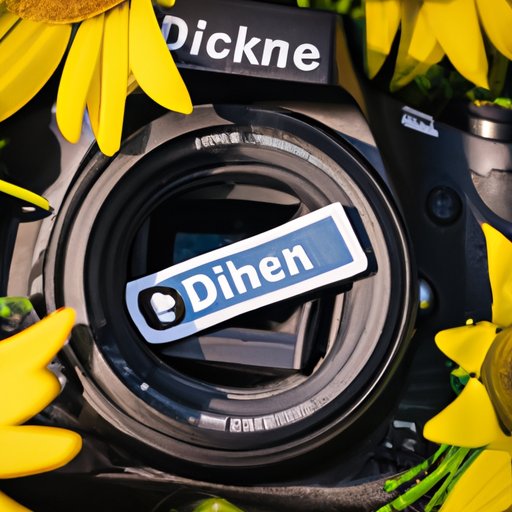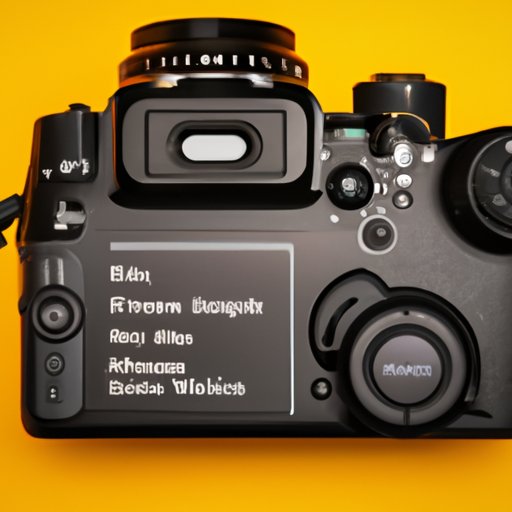Introduction
DSLR cameras are becoming more popular every year, but many people struggle to understand what they are and how they work. If you’re new to photography or looking to upgrade from a point-and-shoot camera, a DSLR camera is a great option. In this article, we’ll provide a comprehensive guide to DSLR cameras for beginners.
Everything You Need to Know About DSLR Cameras for Beginners
Definition of DSLR camera
A DSLR camera, or digital single-lens reflex camera, is a type of digital camera that allows you to interchange lenses and see through the lens via a mirror and prism system. DSLR cameras are known for their high-quality images and their ability to shoot in a wide range of lighting conditions.
Explanation of the major components: lens, mirror, sensor, viewfinder, LCD screen
DSLR cameras have several major components that work together to create a high-quality image. These include the lens, mirror, sensor, viewfinder, and LCD screen. The lens is the primary component that determines the quality and sharpness of an image. The mirror reflects the light coming through the lens up to the viewfinder to allow you to see what you’re photographing. The sensor captures the image and stores it digitally. The viewfinder is used to frame and focus your shot, while the LCD screen allows you to review your images and adjust settings.
Advantages of using a DSLR camera
One of the biggest advantages of using a DSLR camera is the ability to change lenses. This allows you to have more creative control over your images and to capture a wider range of subjects. DSLR cameras also offer better image quality, thanks to their larger sensors and better image-processing engines. Additionally, DSLRs have faster autofocus systems and a wider range of manual controls compared to point-and-shoot cameras.
Types of DSLR cameras: full-frame vs. crop sensor
There are two main types of DSLR cameras: full-frame and crop sensor. Full-frame cameras have a sensor size that is equivalent to a 35mm film frame, while crop sensor cameras have a smaller sensor size. Full-frame cameras offer better image quality and low-light performance, while crop sensor cameras are generally smaller and less expensive.
The Ultimate Guide to Understanding DSLR Cameras
Detailed explanation of each major component
Each major component of a DSLR camera plays an important role in creating a high-quality image, and understanding how they work together can help you become a better photographer. For example, the lens determines the quality and sharpness of your image, while the sensor captures the image and stores it digitally. The viewfinder is used to frame and focus your shot, while the LCD screen allows you to review your images and adjust settings.
Understanding aperture, shutter speed, and ISO
Aperture, shutter speed, and ISO are the three most important settings to understand when using a DSLR camera. Aperture controls the amount of light that enters through the lens, while shutter speed determines how long the sensor is exposed to light. ISO affects the amount of noise or grain in your image. To get a well-exposed image, you’ll need to balance these three settings.
Differences between automatic and manual shooting modes
DSLR cameras offer several shooting modes, including automatic and manual modes. Automatic modes, such as program or aperture priority, are great for beginners or when you’re in a hurry. Manual mode gives you complete control over all of the camera’s settings and is preferred by many professional photographers. Understanding these modes can help you take better photos in a variety of situations.
Tips for taking better photos with a DSLR camera
There are several things you can do to improve your photography skills when using a DSLR camera. Some of these tips can include using a tripod, understanding composition, and using different lenses or focal lengths. Taking the time to learn and practice these techniques can help you create more impactful and visually appealing images.
What Makes a DSLR Camera Different from a Point-and-Shoot Camera?
Definition of a point-and-shoot camera
A point-and-shoot camera is a type of digital camera that is small, lightweight, and easy to use. They are designed for casual or snapshot photography and typically have fixed lenses and limited manual controls.
Major differences between the two types of cameras: size, image quality, versatility, price
There are several major differences between DSLR and point-and-shoot cameras. DSLR cameras are generally larger and heavier than point-and-shoot cameras, but offer better image quality, versatility, and manual controls. However, they are also more expensive and require a higher level of technical knowledge to operate. Point-and-shoot cameras are smaller and easier to use, but are limited in their ability to produce high-quality images.
Which type of camera is best for different types of photography needs
Whether a DSLR or point-and-shoot camera is best for your needs depends on several factors, including your level of experience, intended use, and budget. If you’re just starting out in photography, a point-and-shoot camera may be a good option. However, if you’re interested in learning more about photography or want to take your skills to the next level, a DSLR camera is likely the best choice.
DSLR Cameras 101: The Basics Explained
Similarities and differences among different DSLR camera models
There are many different DSLR camera models available, each with their own specifications and features. However, all DSLR cameras share several common features, including the ability to change lenses and to shoot in manual mode. Understanding the similarities and differences among different camera models can help you choose the right one for your needs.
First steps to using a DSLR camera: setting up the camera, setting shooting modes, adjusting the settings
Setting up your DSLR camera for the first time can be daunting, but it doesn’t have to be. Start by familiarizing yourself with the camera’s controls and settings, then experiment with different shooting modes. Adjusting settings like aperture, shutter speed, and ISO can help you create better images and give you a deeper understanding of your camera’s capabilities.
Basic techniques for capturing great photos with a DSLR camera
There are several basic techniques you can use to capture great photos with a DSLR camera. For example, using a tripod can help you keep your images sharp, while understanding composition can help you create more visually appealing images. Experimenting with different lenses and focal lengths can also help you create more interesting and dynamic photos.

How to Choose the Right DSLR Camera for Your Photography Needs
Factors to consider when choosing a camera: budget, skill level, intended use, camera features, lens compatibility
Choosing the right DSLR camera for your needs depends on several factors, including your budget, skill level, and intended use. Consider factors like camera features, lens compatibility, and image quality when making your decision. It can also be helpful to read reviews and compare different camera models to find the one that best fits your needs.
Reviews of popular DSLR camera models and their features
There are many popular DSLR camera models available, each with their own features and advantages. Some popular models include the Canon EOS Rebel T7i and the Nikon D5600. Reading reviews of different camera models can help you understand their strengths and weaknesses and find the one that is best for your needs.
Tips for finding the best deals on a DSLR camera
DSLR cameras can be expensive, but there are ways to find good deals. Shopping during sales events, buying used or refurbished cameras, and comparing prices from different retailers can all help you save money. It’s also worth considering bundled packages that include lenses and other accessories.
Top 5 Things You Need to Know About DSLR Cameras
Best practices for using a DSLR camera: cleaning the lens, using a tripod, shooting in raw format
Using best practices when using your DSLR camera can help you get the best possible results. Some tips to consider include cleaning your lens regularly, using a tripod to keep your images sharp, and shooting in raw format to allow for more flexibility when editing your images.
Basic troubleshooting tips: camera won’t focus, photos are blurry, images are overexposed/underexposed
Experiencing problems with your DSLR camera is never fun, but it’s important to know how to troubleshoot common issues. If your camera won’t focus, try changing your focus point or using manual focus. If your photos are blurry, make sure your shutter speed is fast enough or use a tripod. Overexposed or underexposed images can be fixed in post-processing by adjusting your exposure settings.
Best resources for learning more about using a DSLR camera
There are many resources available to help you learn more about using a DSLR camera. Some great places to start include online forums and tutorials, photography blogs, and photography books. It’s also worth considering taking a photography class or workshop to gain hands-on experience.
Mastering DSLR Photography: Tips and Tricks for Beginners
Advanced shooting techniques: capturing motion, photographing landscapes, taking portraits
Once you’ve mastered the basics of DSLR photography, there are several advanced shooting techniques you can try. Capturing motion, photographing landscapes, and taking portraits all require different techniques and settings, but can result in stunning images when done correctly.
Special considerations for shooting in low light or artificial light
Shooting in low light or artificial light can be challenging, but it’s still possible to get great results with a DSLR camera. Using a fast lens, increasing your ISO, or using a tripod or other stabilizing device can all help you get sharp, well-exposed images even in challenging lighting conditions.
Editing techniques to enhance your DSLR photos
Edit your DSLR photos can help you enhance the exposure, color, and detail of your images. Some popular photo editing software includes Adobe Lightroom and Photoshop, but there are many other options available. Experimenting with different editing techniques can help you find your own style and create more impactful images.
Conclusion
DSLR cameras are powerful tools for photographers of all levels, offering excellent image quality, versatility, and flexibility. By understanding the major components, shooting techniques, and available resources, you can take your photography skills to the next level with a DSLR camera.
